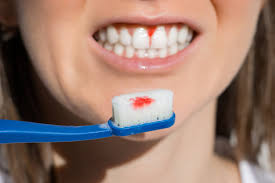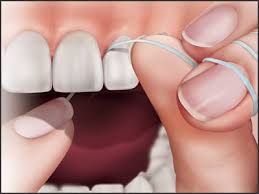It is important to be sure to look after both your teeth AND your gums when keeping up with your oral care routine. They are not one and the same thing. If your gums are bleeding when you brush or floss, you need to take action right away by vamping up your oral hygiene routine. Bleeding gums are usually the start of larger issues developing and are an important warning sign to heed.
WHAT CAUSES BLEEDING GUMS?
Bleeding gums are common, and as a result, are often downplayed as ‘normal’, despite the possibility of leading to gum disease. Bleeding gums are NOT normal. Healthy gums don’t bleed when brushed or flossed. This symptom is a sign that your gums are not being properly cared for.
Bleeding gums are most commonly caused by gingivitis and the buildup of plaque on the teeth and gums. Brushing doesn’t always clean hard to reach spots, particularly around the gumline and in between teeth. As a result, plaque can build up in these areas and lead to gingivitis which causes bleeding gums.
Bleeding gums can also arise from other factors such as bleeding disorders, leukemia, hormonal changes, scurvy or the use of blood thinners.
Left unattended, it will likely progress to more advanced stages of gum disease (periodontitis), so early detection and action is important. Do not ignore this seemingly small issue. It is not small at all.
ARE BLEEDING GUMS NORMAL?
According to the American Dental Association, nearly 60% of people have had bleeding gums, and 33% think that bleeding gums are normal – which is one of the greatest dangers. Bleeding gums are not normal and are early signs of gum disease. Other signs may include bad breath, swollen gums, a poor taste in your mouth, receding gums, and in severe cases, loose teeth.

The bottom line is: If your gums are bleeding when you brush or floss, see your dentist for a professional cleaning and examination. The absolute worst response to bleeding or sensitive gums is to do nothing at all. Also, it definitely does not mean that you should brush your teeth harder or more than the recommended amount. This can actually irritate your gums and do more damage. You should never use a hard toothbrush. ALWAYS use a soft-bristled brush. Remember, plaque is soft and sticky when it forms, so if you’re brushing regularly, you can remove it WHILE it’s still soft and sticky, before it hardens and becomes tartar (which, incidentally, hard brushing couldn’t possibly remove anyway!)
HOW TO TREAT BLEEDING GUMS
The best prevention is simply maintaining proper oral hygiene care. Don’t rush it. Think of it this way: If you’re doing it twice a day, spending 2 minutes brushing and about 2 minutes flossing, shaving a few seconds off here and there by rushing it and not being as complete as you could be if you took time to be diligent and thorough, is just not worth the damage it ends up costing in the long run. Take extra care to gently address the tough to reach areas where plaque builds up. This will be your best defense against bleeding gums. Using the strategies below will prevent against bleeding gums:

Brush twice a day for at least 2 minutes each time: Brushing more than once per day in a circular motion strengthens the tissue around your teeth. Only brushing once a day, or not brushing every day will allow more plaque to build up and develop into tartar, which is impossible to remove without professional treatment. Additionally, although the tartar buildup itself can be removed by professional cleaning, if left there for some time – results in bone loss around the teeth, which will be lost forever.
Flossing daily: Brushing often misses some of those hard-to-reach areas that are responsible for causing bleeding gums, such as between teeth and along the gum line. Flossing allows you to reach just beneath the gumline and remove plaque buildup before it hardens and turns into tartar. It also is excellent for cleaning between teeth, where toothbrush bristles sometimes have a hard time reaching very well.

*Remember not to “snap” it against the gums between your teeth when placing it. Slide it in gently between them, and wrap it around each tooth, in a “c-shape” manner, and then gently slide it up and down to remove the plaque between the teeth.
Unlike brushing, flossing only needs to be done once per day. If you are one of those people who just likes to floss more than once a day because it makes your mouth feel cleaner, just be sure and be gentle. Gum tissues are delicate and need to be cleaned with love!
See a dentist regularly: Visiting the dentist every six months helps to prevent minor issues before they become major ones. Your dental hygienist uses special instruments and cleaning agents to remove tartar that can’t be removed at home, and able to keep extrinsic stains under control through regular removal and polishing. When teeth are cleaned properly, it helps reduce the chance of bleeding gums, and as a result, periodontal disease.
Avoid tobacco: Tobacco use can damage your gums and can also make you far more likely to develop gum disease. It is one of the most important risk factors and greatly increases disease severity.
Maintain a healthy lifestyle: The American Dental Association recommends eating a balanced diet and avoiding between-meal snacking and sugary drinks. Reducing stress from your life can also help prevent gum disease.
If you do notice your gums beginning to bleed, practice some of the tips provided above, and be sure to schedule an appointment with your dentist to help determine the source of the issue and treat it accordingly.
If you are experiencing bleeding gums, contact us here to schedule a complimentary consultation to have them looked at. We’ll help you get them back to a healthy state. Schedule your consultation today – call us at 214-956-9100

